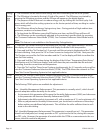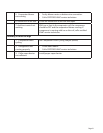
Page 19
7. System low on
refrigerant.
Check refrigerant “sight glass” in 1/4” tubing.
Check for bubbles after system has run for several
minutes. If bubbles present, call a CERTIFIED HVAC service
technician. If sight is clear of bubbles, refrigerant level is OK.
8. Thermostatic
expansion valve power
element losing its
charge.
System will operate as if it were low on refrigerant charge.
Sight glass will be clear. Evaporator coil icing probable.
Call a CERTIFIED HVAC service technician.
9. Low voltage to
compressor, below
103V with compressor
running.
Low voltage will cause compressor overheating and
tripping on overload. Also, can have diculty starting. This
is usually a eld wiring problem which should be corrected
immediately.
10. Cooling system not
sucient for load
If system is determined to run OK but not keeping up, run a
heat gain calculation for the wine cellar and compare with
cooling system capacity.
Evaporator blower runs, but compressor does not
1. System “Anti-Frost“ Observe for several minutes. Compressor should turn on
at termination of “Anti Frost“ Cycle and evaporator clear of
frost.
2. Power o to
compressor.
Check breaker/Refer to #3 above
3. Out of refrigerant. Call a CERTIFIED HVAC service technician to locate leak,
repair and charge with refrigerant
4. Compressor o on
overload.
Determine if compressor is hot. If not, there is another
problem. If yes, shut o power to condensing unit and call
service technician
5. Liquid line solenoid
valve in evaporator not
active.
Remove cover. Locate valve in ¼” copper tube. Check to
see if it is hot. If hot and you can feel a magnetic pull with a
screwdriver, the valve is working. If cold, there is no power
to the valve coil. In this event, with the blower running, the
valve should be powered. Call a CERTIFIED HVAC service
technician.
6. Thermostat
expansion valve power
element lost charge
System will “pump down.” Compressor will stop.
May start occasionally and shut o quickly.
Call a CERTIFIED HVAC service technician.


















